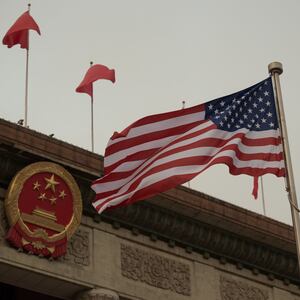By Peter Eisner
In December 2018, the U.S. Patent Office approved one of the strangest applications in its 231-year history, from a Navy engineer who was confident he could design nothing less than a physics-denying craft that could fly at massive speeds, not just across the sky but into outer space and even under the ocean.
Sound familiar? Indeed, if the dreams of Salvatore Cezar Pais, an engineer at the Naval Air Warfare Center Aircraft Division at Patuxent River, Maryland, had borne fruit, the Defense Department itself might have given birth to one of those objects that have struck shock and awe into pilots around the world in recent years—and which provoked U.S. intelligence into studying the phenomenon.
In its long-awaited report on Friday, the Office of the Director of National Intelligence did little if anything to provide answers to the strange midair encounters with what it calls Unidentified Aerial Phenomena, or UAPs, which everyone else calls UFOs. It lists 143 sightings of unknown provenance. But it does not attribute any of the unexplained incidents to extraterrestrials or to secret U.S. technology.
“Most of the UAP reported probably do represent physical objects,” the ODNI report said, given that a majority of UAP were registered across multiple sensors, to include radar, infrared, electro-optical, weapon seekers, and visual observation.” They just don’t know what they are. They’re going to study it some more.
But Pais, the Navy engineer, thought he could build a better UAP. His was a triangular craft of undetermined size whose centerpiece was to be an Inertial Mass Reduction Device, a contraption that would use fusion nuclear power and microwaves to create a vacuum that would alter its mass and allow it to accelerate at high speed.
Impossible, astrophysicists tell SpyTalk: Such a craft could not be built with known technology and probably could never exist in the natural world. “Puzzling,” one put it to SpyTalk. “Nonsense,” said another. (More on that below.)
Yet two years later, Pais signed over a related patent application to the Navy, this one for a “Plasma Fusion Compression Device,” which, if it worked, would basically be a nature-bending breakthrough in creating a cold fusion generator. Together, the inventions became known as the “Pais Effect.”
Why both the Navy and the Patent Office (since 1975, the U.S. Patent and Trademark Office) considered such ideas remains a mystery. Did approval have anything to do with the recent leakage of videos of Navy pilots going ga-ga over UAP/UFOs?
Pais, who holds a doctorate in engineering from Case Western Reserve University, could not be reached for comment. His attorney during the patent process, Mark Gadd, referred all questions to a U.S Navy spokesman at the Naval Air Warfare Center Aircraft Division.
Testing, Testing
“The command conducted testing from October 2016 to September 2019 on the ‘Pais Effect,’ which is the basis for the patents,” NAWCAD spokesman Timothy Boulay told SpyTalk in an email. “When testing concluded, the ‘Pais Effect’ could not be proven to exist.” The project was then dropped, he said.
The three-year project cost $508,000, Boulay said, with 90 percent going to salaries and the remainder for equipment. “Dr. Pais left NAWCAD in June 2019, and there isn’t anyone at NAWCAD who can speak on his behalf,” he said.
The design of the vehicle described in the Navy patent is oddly similar to testimony and grainy videos recorded by U.S. Navy pilots. The videos show the Tic Tac-shaped craft performing strange maneuvers in the air that appear not to behave according to the laws of aerodynamics.
After dropping the “Pais Effect” project, Boulay said, “no further research has been conducted, and the project has not transitioned to any other government or civilian organization.” Obtaining a patent was not unusual, he said, even for a device as bizarre as this one that ultimately did not pan out.
“As a federal lab, NAWCAD files numerous patents every year, Boulay said. “Issuance of a patent doesn’t necessarily indicate the presence of the technology: It can also protect a concept. In this case, the patents protected proprietary technology concepts until additional research was done.”
The patent did generate a stir in technical and military publications and among techno-debunkers when it was filed originally in 2016. The Pakistan Defence website, for example, opened a news thread in 2019 headlined, “The US Navy secretly designed a super-fast futuristic aircraft resembling a UFO, documents reveal.”
Spoofing the Opposition?
Reporting at the time brought up the possibility of a clandestine race for exotic technologies in the U.S., China and Russia. Other conjecture held that U.S. sources were allowing selective leaks of information about technology that did not exist, like, say, a super-aircraft powered by improbable forces, in a strategic deception operation to unnerve America’s major adversaries. As of 2020, the Federation of American Scientists annual list of secret patents had grown to almost 6,000.
Yet the design for this particular craft was anything but secret. Officials were willing to discuss it, as was its inventor. In his 2018 patent application, Pais described his vehicle in some detail, complete with diagrams. It “includes an inner resonant cavity wall, an outer resonant cavity, and microwave emitters,” he wrote. The craft would contain an inert gas such as xenon, a vacuum would be created outside the vehicle, and the microwaves would produce vibrations in the vacuum. Crew quarters would be encased in a Faraday cage to protect them from microwave radiation.
The result, said the inventor, would be a hybrid craft that “would move with great ease through the air/space/water mediums, by being enclosed in a vacuum plasma bubble/sheath.”
Pais did acknowledge at one point that his invention was extremely hypothetical, nothing less than changing known physics.
“If we can engineer the structure of the local quantum vacuum state,” he wrote in his patent application, “we can engineer the fabric of our reality at the most fundamental level (thus affecting a physical system's inertial and gravitational properties). This realization would greatly advance the fields of aerospace propulsion and power generation.”
That description was head-scratching for many physicists.
“I find it puzzling frankly that the patents were awarded,” said Stephen Webb, a physicist at the University of Portsmouth, England, and author of If the Universe is Teeming with Aliens… Where is Everybody? “It’s like this wonderful wish list of things that we want. So, there’s essentially unlimited free energy, there is high temperature superconductivity, which will transform society… and inertial mass reduction. I mean it doesn’t make sense in terms of physics.”
Others were more blunt. “It is nonsense,” said Jeremiah Ostriker, an astrophysicist and professor of astronomy at Columbia and Princeton universities. “If an airplane tosses stuff overboard its inertial mass decreases, but its momentum decreases by the same fraction and so it does not go any faster.”
The question would be then, why would the Navy apply for a patent for an impossible dream? In fact, the U.S. Patent Office initially rejected Pais’ inertial mass proposal on the grounds it could never be built. Patent law rulings say that an invention must be “enabled,” not necessarily in working order, but capable of being built as described.
Philip J. Bonzell, the patent examiner assigned to review Pais’ flying machine, rejected his application on that basis—he said it could not be built. The power required to make the craft fly would be absurdly high—“three orders of magnitude greater than a neutron star,” he wrote in rejecting the patent. “It would take 10^9 power teslas.” [The tesla, or measurement of the strength of a magnetic field, is named after Nikola Tesla, the Serbian-American inventor, not after Elon Musk’s cars.] “The Examiner holds that these levels are not feasible with current technology so how would someone of ordinary skill in the art be able to know how to create this craft?” Bonzell wrote.
Expert Pushback
Nevertheless, Pais’ patent attorney issued a rebuttal and said that Bonzell was wrong, citing peer reviews in scientific publications and the word of the Navy Warfare section’s chief scientist, James Sheehy, who declared that the invention was “enabled,” and being tested. “The examiner [Bonzell] is not an active researcher, and is not on the frontline of science, as the peer reviewers typically are,” the rebuttal from the patent attorney sniffed.
During the application process, Sheehy, who holds a Ph.d. in physiological optics, also defended issuance of the patent. He said Pais’ test program for the experimental vehicle was promising. “Based on these initial findings, I would assert this will become a reality,” he said in a letter to Bonzell. “China is already investing significantly in this area, and I would prefer we hold the patent as opposed to paying forever more to use this revolutionary technology.”
Several months after the patent examiner’s “final rejection,” the patent was issued anyway. Bonzell, contacted by Spytalk, said he was not able to comment beyond his findings in the records filed with the patent application. Sheehy did not respond to a request for comment.
However, a third physicist, Terry Matilsky, emeritus professor of astronomy and physics at Rutgers University, said Bonzell was just pointing out something basic: the concept of reducing mass, which is central to the patent, is counter to all known physics, starting with Einstein’s theory of special relativity, and the well-known formula E=mc^2.
“How can you reduce mass anyway?” he asked. “You are violating the principle of the conservation of energy. At that point, I suffer from a disconnect and I need to try to piece things together from that point of view. How can it even be possible?”
It has been suggested that the United States might have been engaging in disinformation by claiming to have made a leap in developing exotic aircraft with unknown propulsion systems. The problem, however, is that Chinese and Russian physicists alike would identify the same problem that Matilsky, Ostriker and Webb identified—and quickly dubbed it nonsense.
“The cautionary aspect is that the universe I’d like to live in is the Star Trek universe,” said Webb. “You know, where we would be in contact with alien species and we’re learning things from them. It would just be an interesting place. Yeah, I would love for that to be the universe in which we live.”
The problem, he said, is that the evidence for a Star Trek on Earth is just not there.
Co-published with SpyTalk, where Jeff Stein leads an all-star team of veteran investigative reporters, writers, and subject-matter experts who will take you behind the scenes of the national security state. Subscribe to get full access to the newsletter and website.








